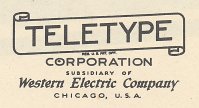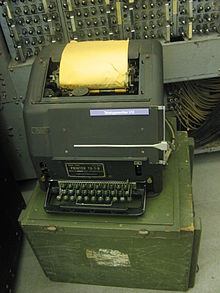Teletype Corporation
| Teletype Corporation
|
|
|---|---|
| legal form | Corporation |
| founding | 1928 |
| resolution | 1982 |
| Reason for dissolution | AT&T monopoly logging |
| Seat | Skokie, Chicago, Illinois |
| Branch | Teletype |
The Teletype Corporation was an American manufacturer of teleprinters . The company was created in 1924 from the merger of two previously competing companies to form the Morkrum-Kleinschmidt Company . In 1928 it changed its name to Teletype Corporation . The headquarters were in Skokie , a suburb of Chicago in the US state of Illinois .
In 1930 the company was taken over by the American Telephone and Telegraph Company and relocated to subsidiary Western Electric Company . The company remained a largely independent unit until the AT&T monopoly was broken up in 1982.
The devices manufactured under the brand name Teletype dominated the American market especially during the Second World War . The main customers were the telephone companies of the parent company AT&T and the US federal government . They were also widespread in the German Reich through replicas made under license from C. Lorenz AG , Berlin .
history
prehistory
Morkrum Company
One of the two main companies of the company was the Morkrum Company , founded in 1902 by the entrepreneur Joy Morton and the engineer Charles Krum . The electrical engineer Frank Pearne first approached the entrepreneur with the idea of developing a "writing telegraph". Joy Morton wanted to get another opinion about the feasibility and possible return first and turned to Charles Krum, the vice president of the Western Cold Storage Company, which was headed by his brother Mark Morton. A laboratory was set up on the Western Cold Storage company premises so that Krum could support the development. When Frank Pearne lost interest after a year, Krum continued the work alone and secured a first patent in August 1903. From 1906 his son Howard Krum joined the development and in August 1907 secured the development of the "Start-stop procedure" for synchronization. The first device was completed in 1908 and was tested at Alton Railroad . In 1910, the first commercial Morkrum Printing Telegraph began operating on the Post's telegraph line between Boston and New York City .
Kleinschmidt Electric Company
The German-American Edward E. Kleinschmidt had been running his own experimental laboratory since 1898, in which he successfully developed an electrical blocking system and signaling systems for rail vehicles with the engineer George Seely. But he was also interested in telegraphy and, after receiving his first patents in this field, founded the Kleinschmidt Electric Company . In 1916 he developed a pen with keyboard for transmission in the Baudot-Murray code .
Western Electric Company
The equipment subsidiary of the AT&T group, which completely controls the telephone market, initially produced a number of its own teleprinters, the design of which was still being developed at Bell Telephone Laboratories . Below is the “10-A Printing Telgraph” with a type wheel on a vertical axis.
Morkrum-Kleinschmidt Company (1924–1928)
After Howard Krum's patent for the start-stop process was published in 1918, Kleinschmidt quickly recognized its advantages and modified his device accordingly. This quickly led to a patent dispute, until finally both sides realized that their respective inventions could only be successful in combination. In 1924 they agreed to jointly found the Morkrum-Kleinschmidt Company in Skokie, a suburb of Chicago.
The "Teletype 14" model, which was manufactured from 1924, is considered the first commercially successful teleprinter. It was a strip chart recorder developed mainly by Morkrum, of which around 60,000 were produced in various variations in the following years. In the same year, C. Lorenz acquired a license to use the patents in Germany and to produce the Model 14 as a replica. The installation of imported devices in German post offices for test purposes was not a success. In contrast to the freedom of use in the United States, the strict German postal monopoly only allowed Reichspost to operate. As long as the technology could not be installed in the offices of interested entrepreneurs, but rather the way to the post office was necessary for each message, there were hardly any advantages over the usual high-speed telegraphy.
Teletype Corporation (1928–1982)
The company changed its name in 1928 and was taken over by the American Telephone and Telegraph Company in 1930, just two years later, and left to the subsidiary Western Electric Company . Western Electric then stopped developing and producing their own teleprinters.
The most famous teleprinter model was the Teletype 15 model . This teleprinter was developed in 1930 and was essential for telex communications for the U.S. military during World War II. Although it was technically obsolete by the Second World War, the Model 15 was so widespread that it was continuously produced until 1963 with a total of over 200,000 units. The model 15 was also available in a variant without a keyboard, only to be used as a receiver and like a printer. It was used in this configuration by many news agencies and newspaper publishers until the late 1960s .
ASCII teletype
For the American TWX network, a kind of improved teletype network, Teletype developed the models 33, 35, and later others, partly or fully electronic. They differ from the classic teletypewriter in that they usually have a 20 mA current interface, which is operated at 110 baud and which, to a large extent, use the ASCII code developed by Teletype .
The Teletype Model 33 , often referred to as the ASR-33 , introduced in 1963, achieved particular popularity as an early computer terminal. The otherwise identical Model 32 was intended for use with the Baudot code . A total of over 600,000 units of both models were produced. The abbreviation ASR refers to the version with a tape reader and punch , which Teletype called Automatic Send and Receive . There were also other variants such as B. KSR, Keyboard Send and Receive , without punched tape. Its use in connection with computers made the ASCII code popular in EDP and laid the foundation for the serial interface that is still widespread today . Traces of the teletypes can still be found today in the interface designations commonly used in Unix- like operating systems , such as / dev / ttyX , where "tty" is an abbreviation for teletype.
The 20 mA current loop is still called the TTY interface today.
AT&T Teletype (1982–1990)
Western Electric went completely into the new AT&T, which was newly formed after the old parent company was split up. The teleprinter company then operated as AT&T Teletype for a few years . Around 1990 the remaining company and with it the telex business was finally dissolved.
Products
Morkrum Company
- Morkrum Printing Telegraph - The first telegraph sold by Morkrum in 1908. After a test by Alton Railroad in 1908, a "Blue Code Version" was part of the Postal Telegraph Company's first commercial telegraph connection between Boston and New York City from 1910 onwards . In 1914, a "Green Code Version" was installed via a link from the Western Union Telegraph Company for the Associated Press to deliver news to New York City newspapers .
- Morkrum Model 11 Tape Printer - The Model 11 reached about 45 words-per-minute, but was only slightly faster than the Blue and Green Code Systems. The device was based on the European Baudot Telegraph System. It used a piece of gummed paper that could be stuck onto a blank telegram form. In addition, it was the first teleprinter successfully tested on an airplane.
- Morkrum Model GPE Perforator - This hole punch was developed for the "Green Code" devices around 1913 and the company received a patent for it in 1914.
- Morkrum Model 12 Typebar Page Printer - A page printer based on the mechanism of an Underwood typewriter and from 1922 to 1925 under the name Morkrum until 1929 under the name Morkrum-Kleinschmidt and until 1943 under the name Teletype Corp. was produced.
Western Electric Company
- 10-A Printing Telegraph - A model after a design by Bell Telephone Laboratories , one of a series of machines that Western Electric had manufactured before the Teletype Corporation purchased it in 1930.
Morkrum-Kleinschmidt Company
- Teletype Model 14 (from 1924) - strip chart recorder based on the patent of Howard Krum and Morton Sterling. A series of devices developed from this, of which a total of 60,000 pieces were produced. In Germany, various replicas were made by C. Lorenz , especially the "T32 Lo" and "T35 Lo" models.
Teletype Corporation
- Teletype Model 15 (from 1930) - sheet writer based on the joint patent of the developers Sterling Morton, Howard Krum and Edward E. Kleinschmidt.
- Teletype Model 19 (from 1940) - variant of the model 15 with integrated hole punch and a transmitter distributor taken over from model 14.
- Teletype Model 20 (from 1940) - paper writer with a distinction between upper and lower case letters. Depending on the variant, it was a transmit-only or receive-only device. It used a 6-bit “Teletypesetter” code, a sort of intermediate step from the 5-bit Baudot Murray to the 7-bit ASCII .
- Teletype Model 26 (from 1946) - low-price model with 5-bit code and a type wheel.
- Teletype Model 28 (from 1951) - device series originally only for the US military, but was available in normal stores from 1953.
- Teletype Model 29 (from 1950) - 8-bit device for IBM BCD ( Binary-Coded Decimal ).
- Teletype Model 32 and Teletype Model 33 (from 1963) - low-price models with type wheel originally for the US Navy. Model 32 with 5-bit code and Model 33 with ASCII. A total of 600,000 devices were produced in all variants.
- Teletype Model 35 (from 1963)
- Teletype Inktronic Terminal (from 1966)
- Teletype Model 37 (from 1969)
- 4100 Paper Tape Equipment (from 1972)
- Teletype Model 38 (from 1972)
- Teletype Model 42 and Teletype Model 43 (from 1977) - Model 42 with 5-bit code and Model 43 with ASCII.
- Teletype Dataspeed 40 (from 1979) - unit consisting of screen, high-speed printer and synchronous modem for speeds of 2400, 4800 or 9600 baud. In-house use for the AT&T Switching Control Center System but also in commercial sales.
From model 28 onwards, most of the devices were available as RO ( Receive Only ), KSR ( Keyboard Send and Receive ) and ASR ( Automatic Send and Receive - with keyboard, printer, reader and built-in hole punch).
Web links
- Teletype Corp. . Detailed product catalog. In: Baudot.net
Individual evidence
- ^ The Teletype Story. (PDF; 6.7 MB) Teletype Corporation, 1957, accessed July 11, 2013 .
- ↑ Description, Typebar Page Printer (Model 15) , Volume Bulletin No. 144. Teletype Corporation, Chicago 1931.
- ↑ Teletype Model 15 Page Printer . Retrieved August 26, 2011.
- ↑ History of Telegraphy from the Teletype Museum (PDF; 83 kB) Retrieved March 18, 2012.





